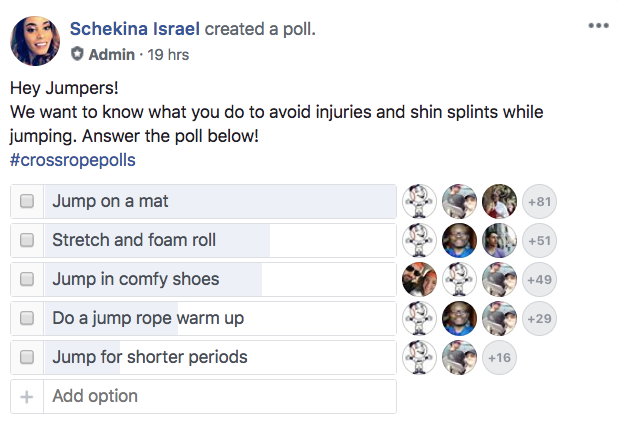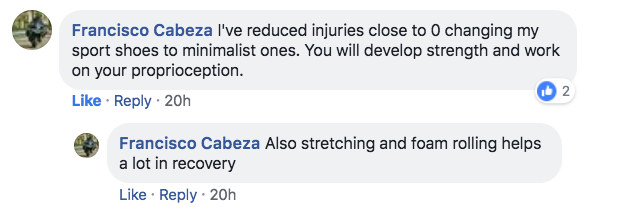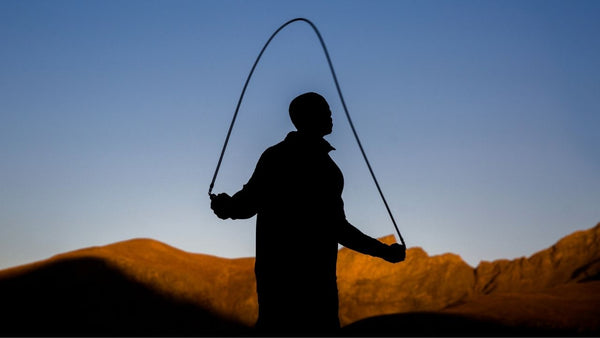Injuries are never fun to deal with.
You’re putting in the hard work, making progress, noticing improvements, and then out of nowhere, an injury strikes.
You get a sharp, shooting pain in your ankle. Or your shins start hurting while jumping. Or there’s just general pain that holds you back.
All that hard work and progress begins to feel like it’s slipping away.
Most of us have sustained at least one injury along the way to our fitness goals. At times, it seems as if it’s part of the process. But there are things you can do to avoid injuries and particularly shin splints when jumping rope.
In this post, we’ll share some tips that can help you avoid injuries and stay healthy while pursuing your fitness goals.
Important Note
Before you jump into the article, please note that we are not medical professionals, nor is the following a substitute for medical advice. Please consult your physician immediately if you sustain an injury or experience excessive pain as a result of exercise.
However, the content of this post is based upon extensive personal experience, as well as feedback from thousands of jumpers. We hope you find it useful!
Jump Rope Safety: General Notes
Jump rope training is unique because it is a self-limiting exercise.
When we say self-limiting, we mean that jumping rope naturally keeps you from using bad form over an extended period of time. If your technique is wrong, you’ll trip up very quickly.
It’s also a very low-impact activity if it’s done properly.
Using a good jumping technique requires you to jump on the midsoles of your feet so the impact dissipates evenly through your body. This is unlike the high-impact, heel-to-toe strikes that happen with other endurance sports, like running.
Pro Tip: read our post on jumping rope vs. running for a full comparison.
Even though jumping rope is a safe activity overall, it doesn’t mean you can't get injured. There are always risks involved with any form of fitness training and it’s important to make yourself aware of them so you know what to pay attention to during your workouts.
We asked our 94K members in our jump rope fitness community to see what techniques they use to avoid injuries. Here’s what they said:
In this post, we’ll go over each of these solutions in more detail. The following jump rope tips should give you a good overview of how to prevent injury jumping rope.
How To Prevent Injury Jumping Rope
Start by watching this in-depth video, which will explain how you can reduce your chances of injury and shin splints when jumping.
Take a few minutes to watch the first of the jump rope videos provided below or scroll down to the tips.
Pro Tip: don’t forget to subscribe to our YouTube channel for more workouts and tutorials. Also, check out our free jump rope app for beginner-friendly workouts.
Alright, let’s dive into our tips.
1. Listen To Your Body + Recognize The Signs
There’s a difference between normal pain and bad pain.
While sometimes it’s important to “push through the pain” and finish your last rep (at any cost), however, you can’t ignore the warning signs of injury.
Here are some signs of both normal and bad pain:
Normal Pain: muscle soreness is a mild tenderness, tired + burning sensation while exercising OR a dull, tight + achy feeling at rest. You’ll typically notice normal pain during exercise or 24-72 hours after your workout. Muscle soreness also improves with stretching.
Bad (Abnormal) Pain: sharp shooting pain that inhibits mobility, visible swelling, extreme tenderness that doesn’t go away, and chronic fatigue.
In any effective workout regimen, you should encounter some normal pain (especially if you’re pushing yourself and making progress). It’s a sign that your muscles are being challenged, which is necessary for growth.
Remember, these are the muscles engaged with weighted jump rope training:
A heavy jump rope adds more resistance. With more resistance comes more muscle engagement.
But the “no pain, no gain” saying is often poor advice. (Just because it rhymes doesn’t mean it’s true).
It’s extremely important to be aware of your body and to know your own limits. You want to push yourself, but only to a point where you experience normal pain.
Ignoring the early warning signs of bad pain can lead to more severe muscle, tendon, ligament, joint injuries, and even irreversible damage requiring surgery in some cases.
Being able to spot + label pain ahead of time is crucial to injury prevention.
Key Takeaway
Normal pain and soreness associated with any effective workout are fine and expected. But be wary of any signs of bad pain - any sharp pains in the joints or muscles. If you do experience any kind of abnormal pain, make sure to stop jumping and have the area of concern checked out by a professional.
2. Choose The Right Surface To Jump On
We've built our Crossrope system to be extremely versatile so you can use it on practically any surface. This portability is what makes jumping rope so much fun.
But it's important to understand how the surface you jump on plays a role in injuries.
Can You Jump Rope On Concrete?
If you’re jumping outdoors, hard surfaces (like concrete or asphalt) are often the leading cause for shin splints. Concrete is very dense and doesn’t offer any shock absorption when you land, which puts more stress on your joints compared to softer surfaces like rubber or wooden flooring.
To minimize your chances of injury and shin splints, we don’t recommend jumping directly on concrete. If concrete is your only option, we encourage you to keep your volume and intensity low (nothing high-impact) and look into getting yourself a good jump rope mat.
If you need one, check out the Crossrope LE Jump Rope Mat.

Key Takeaway
The surface you jump on matters. Is jump rope bad for your joints? The answer is complicated, which is why it’s important to stick to softer surfaces (like rubber or wood) or get a jump rope mat to protect your joints.
If concrete is your only option, make sure you keep your volume and impact low.
3. Get Good Shoes
You want to make sure that your jumping in good shoes if you’re trying to prevent injury jumping rope. Generally, you want shoes to:
-
Protect your feet from injury during exercise
-
Act as good shock absorbers when your foot strikes the ground
-
Keep you comfortable
-
Make you look badass when you’re jumping
We’ve written a full article on how to choose the best jump rope shoes, so if you’re interested to see our top recommendations, check this out:
Best Jump Rope Shoes: Ultimate Guide To Choosing The Right Shoe
Key Takeaway
Get shoes that offer good stability, ankle + arch support, as well as sufficient cushioning in the midsole. Avoid shoes that have deep grooves, an elevated heel, or a platform.
4. Pay Attention to Jumping Volume
We've talked a lot about training volume in the past. How much and how often you jump rope will have a huge impact on injuries, particularly if you're new to jump rope training.
We find that beginners often jump too much.
Excitement + eagerness to learn gets the best of them and they stop paying attention to volume.
Your body needs time to get used to the new stress that comes with jumping rope. It’s essential that you start slow and build up as your body adapts.
Pro Tip: read our post on how often you should jump rope where we outline five important questions that you need to ask yourself to figure out exactly how much jumping is enough.
Always look to mix things up—play around with different intensities + durations to keep your training fresh, but always pay attention to the signals your body is sending you (never forget tip #1). Even though longer and higher intensity sessions create more stress on your joints, it doesn’t mean all of your jump rope workouts need to be short and light.
If you’re experiencing excessive soreness from long sessions, scale it back a bit.
Key Takeaway
Always be aware of how much you're jumping and make sure to adjust your volume depending on the signals your body is sending you.
If you're completely new to jumping, don't let your excitement get the best of you. Start slow and build up your volume as your body adjusts to the new style of stress.
5. Don’t Skip Your Warmup
It’s really easy to skip your warmup, especially if you’re in a rush.
The truth is, a good warmup is absolutely mandatory if you want to minimize your chances of injury and maximize your performance + results.
A short, effective jump rope warmup routine helps increase your heart rate, blood flow, body temperature, respiration, and perspiration rate. It further prepares your joints for action which increases your flexibility so you can do your exercises with better form.
Fortunately, the jump rope is one of the best tools to use for your warmup.
If you want to learn more about how to structure a warmup for skipping, we've got both a beginner and advanced warmup routine to show you here:
Jump Rope Warmup Routine for Jumpers of All Fitness Levels
For a quick and effective jump rope warmup, watch this video:
Key Takeaway
Always dedicate a few minutes before your workout to warm up and get your blood flowing, muscles engaged, and your heart rate up. This is one of the most important things you can do for jump rope injury prevention.
6. Stretch Well + Stretch Often
Similar to warming up, a good stretch after your workout and on your off days is an effective way to minimize your chances of injury.
When it comes to jump rope training, some of the key muscle groups you want to stretch are your calves, hamstrings, quads, glutes, and lower back.
On top of stretching, it helps to regularly massage your feet and calves. If you have a foam roller, use it often to get deep into the tissue of your muscles.
Key Takeaway
Stretching will help you minimize soreness, improve the speed of recovery between workouts, and reduce your chances of injury.
7. Walk It Off
Don’t underestimate the power of a good walk as a form of active recovery. Walking can speed up your recovery time, by boosting blood flow through sore, fatigued muscles.
If you have knee pain after jumping rope or hip pain after jumping rope, this one’s for you.
Several studies have shown that walking reduces joint pain, especially in the knees + hips. If you’re looking for a great way to reduce your chances of injury, try walking around the block after your jump rope workout.
Key Takeaway
Keep it simple. Sometimes the best way to protect your body is to go back to the basics and walk it off.
Before We Go
We love creating and sharing fun and unique jump rope workouts. And we’ve got a lot of them here on the Crossrope Blog.
But one of the best places to find and share new jump rope workouts is inside our fast-growing jump rope fitness community.
That’s where you’ll find some of our best jump rope workouts that we share with jumpers all around the globe. If you’re looking to try something different and have fun with your fitness again, join our jump rope fitness challenge today and be part of our growing community.
If you want to get access to more fun workout and learn new skills and exercises, download our Jump Rope App! The app has a library of comprehensive jump rope tutorials which will help you become a jump rope pro in no time!
Your Turn
There you have it. The tips we've outlined in this post should help you minimize your chances of injury when using the jump rope as part of your training.
But we're curious - have you experienced any injuries with jumping rope in the past? What was the cause and how did you get through it?
We'd love to hear your responses in the comments below.














